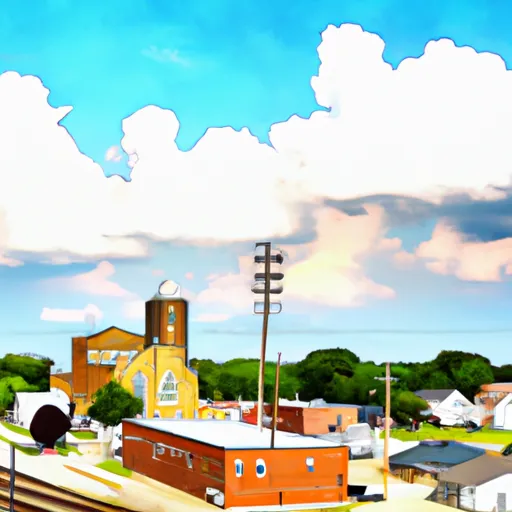-
 Snoflo Premium
Snoflo Premium
Get unlimited access to all our content
With no Ad interruptions! - Start Your Free Trial Login with existing account
Johnsonville
Eden Index
Climate
8.3
•
Recreation
2.8
•
Community
•
Safeguard
4.3/10

Johnsonville is a small village located in Wayne County, Illinois, known for its picturesque landscapes and outdoor recreational opportunities. The climate in Johnsonville is characterized by hot and humid summers, with temperatures often reaching the high 80s and occasionally exceeding 90 degrees Fahrenheit. Winters are typically cold, with temperatures dropping below freezing and occasional snowfall.
The village is surrounded by several bodies of water, including ponds, creeks, and the nearby Skillet Fork River, which offers opportunities for fishing and boating. The hydrology constituents in the area mainly consist of freshwater sources.
Outdoor enthusiasts can enjoy various recreational activities in Johnsonville. The area is renowned for its hunting and fishing opportunities, with abundant wildlife and a diverse range of fish species. There are also several parks and nature preserves nearby, providing opportunities for hiking, camping, and birdwatching. Additionally, the village is close to several state parks, offering additional outdoor recreational options such as biking, picnicking, and horseback riding.
Overall, Johnsonville provides a charming setting for those seeking outdoor adventure and a chance to enjoy nature's beauty.
What is the Eden Index?
The Snoflo Eden Index serves as a comprehensive rating system for regions, evaluating their desirability through a holistic assessment of climate health, outdoor recreation opportunities, and natural disaster risk, acknowledging the profound impact of these factors on livability and well-being.
Climate Health Indicator (CHI): 8.3
Johnsonville receives approximately
1109mm of rain per year,
with humidity levels near 82%
and air temperatures averaging around
13°C.
Johnsonville has a plant hardyness factor of
6, meaning
plants and agriculture in this region thrive during a short period during spring and early summer. Most
plants will die off during the colder winter months.
By considering the ideal temperature range, reliable water supplies, clean air, and stable seasonal rain or snowpacks, the Climate Health Indicator (CHI) underscores the significance of a healthy climate as the foundation for quality living.
A healthy climate is paramount for ensuring a high quality of life and livability in a region, fostering both physical well-being and environmental harmony. This can be characterized by ideal temperatures, reliable access to water supplies, clean air, and consistent seasonal rain or snowpacks.
Weather Forecast
Streamflow Conditions
Wabash
Area Rivers
Wabash
Snowpack Depths
Wabash
Reservoir Storage Capacity
Wabash
Groundwater Levels
Recreational Opportunity Index (ROI): 2.8
The Recreational Opportunity Index (ROI) recognizes the value of outdoor recreational options, such as parks, hiking trails, camping sites, and fishing spots, while acknowledging that climate plays a pivotal role in ensuring the comfort and consistency of these experiences.
Access to outdoor recreational opportunities, encompassing activities such as parks, hiking, camping, and fishing, is crucial for overall well-being, and the climate plays a pivotal role in enabling and enhancing these experiences, ensuring that individuals can engage in nature-based activities comfortably and consistently.
Camping Areas
| Campground | Campsites | Reservations | Toilets | Showers | Elevation |
|---|---|---|---|---|---|
| Lake Tom Bailey | 32 | 299 ft | |||
| Turkey Fork Rec. Area | 76 | 278 ft | |||
| Shepard State Park | None | 16 ft | |||
| Sam Dale Lake Conservation Area | None | 493 ft | |||
| Davis Bayou - Gulf Islands National Seashore | 52 | 19 ft | |||
| Clarkco State Park | None | 273 ft | |||
| Maynor Creek Waterpark | None | 362 ft | |||
| Stephen A. Forbes State Park | 135 | 604 ft | |||
| Archusa Creek Waterpark | 69 | 315 ft | |||
| Charley Brown City Park | None | 487 ft |
Nearby Ski Areas
Catastrophe Safeguard Index (CSI):
The Catastrophe Safeguard Index (CSI) recognizes that natural disaster risk, encompassing floods, fires, hurricanes, and tornadoes, can drastically affect safety and the overall appeal of an area.
The level of natural disaster risk in a region significantly affects safety and the overall livability, with climate change amplifying these risks by potentially increasing the frequency and intensity of events like floods, fires, hurricanes, and tornadoes, thereby posing substantial challenges to community resilience and well-being.
Community Resilience Indicator (CRI):
The Community Resilience Indicator (CRI) recognizes that education, healthcare, and socioeconomics are crucial to the well-being of a region. The CRI acknowledges the profound impact of these elements on residents' overall quality of life. By evaluating educational resources, healthcare accessibility, and economic inclusivity, the index captures the essential aspects that contribute to a thriving community, fostering resident satisfaction, equity, and social cohesion.

